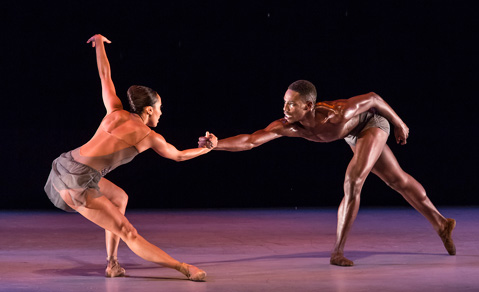Review: Alonzo King LINES Ballet at the Granada
San Francisco-Based Company Wows on Wednesday, October 2

A single silver strand falls from ceiling to floor. Rippling and undulating, it sparkles in the stage lights. Near its base, one woman paws at the stage with one foot like a bird scratching for food. She lifts her hands to claw at her chest and then tosses her hips in tight circles, at once fierce and fragile.
“Meyer” (2013) is Alonzo King’s homage to composer and bassist Edgar Meyer, whose soaring score underpins the work. As bows draw faster across strings, the strand of quavering silver becomes three, then five, then a glittering sheet, and the dancing builds from solo to trio to a stageful of bodies leaping and wheeling. Out of this near-chaos emerges a pas de deux that encompasses the central duality of this company: a dance between articulation and abandon, control and release. One moment, she’s doubled over, legs tightly crossed as he holds her hips and spins her on the axis of her toe shoe. The next moment, they’re falling, running backward so fast it seems certain they’ll end up sprawled on the floor.
It isn’t until one man turns his back to the audience, walks upstage, and dips his hand into the silvery flow that suspicions are confirmed: water pools and splashes in his palm, and his back and arms respond with fluid rippling.
As the dance develops, order yields more and more to chaos: A woman in a whimsical wire-rimmed skirt hops about as her partner rolls on the floor, stuffing his mouth with crumpled papers. On a lesser company, such audacious departures from classical technique might collapse. With LINES, just when things seem to have tipped too far, a single stunning arabesque is all it takes to right it.
“Dancing in the Rain,” from two years earlier, can be seen as a partner dance to “Meyer” insofar as both works feature falling water. Yet set as it is here — to a series of searing, melancholy Sephardic songs — “Dancing in the Rain” strikes a very different tone. Again, the action rises from a single human form to a full stage of bodies bouncing around like excited molecules, though this time their fervor feels less like a party and more like a prayer. Among the standout moments in “Dancing in the Rain” is a male duet in which one partner falls repeatedly backward, only to be caught each time by the hands — and then the feet — of his reclining partner. Though the “snow” that pours down at the end has a certain visual appeal, the real pleasure of this work is in the human tableau unfolding down below.



